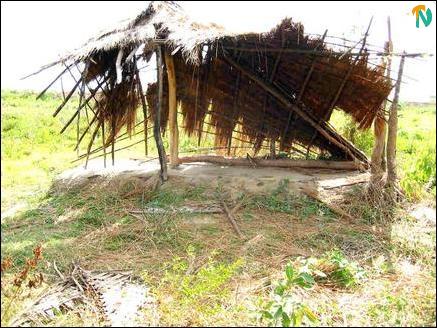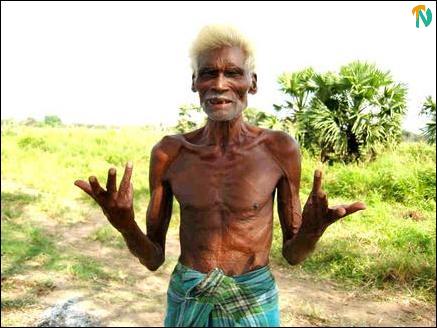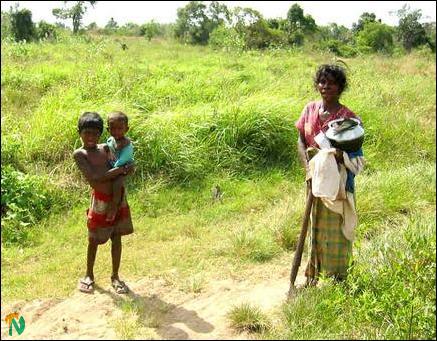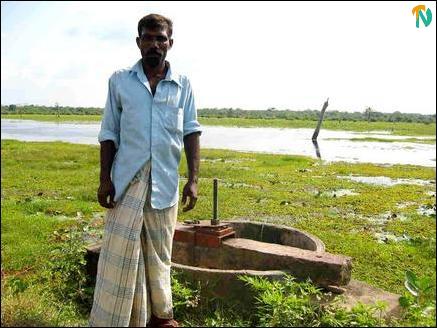
Defying C.I dogma, massacre village rises from ashes
[TamilNet, Tuesday, 27 May 2003, 13:30 GMT]
The Sri Lanka army massacred seventeen villagers, including six children, and burnt and razed to the ground Thoni Thaattamadu, an impoverished Tamil hamlet on the east coast’s remote interior 16 years ago on May 27, 1987. The massacre was an integral part of a counter insurgency (C.I) campaign by Sri Lankan armed forces. The village remained a no go zone since then, until the Liberation Tigers signed a ceasefire agreement with Colombo in February last year.
Former residents who dared to venture into the area in search of lost cattle were shot dead or maimed by SLA patrols, or simply disappeared. Yet the people of Thoni Thaattamadu are today engaged in a determined struggle, unaided and unnoticed, to rebuild their village and farm their lands which for many years had lain submerged in the inexorable tide of the dry zone forest.
 A dilapidated shelter built by a returnee on the floor of a house that was demolished by the SLA in 1987
A dilapidated shelter built by a returnee on the floor of a house that was demolished by the SLA in 1987
Thoni Thaattamadu is about sixty four kilometres north of Batticaloa town, in the interior jungles of the Vaakarai region.
The hamlet’s name in Tamil means ‘the trough in which the canoe was buried’.
Thoni Thaatamadu was among hundreds of Tamil villages that fell victim to British-US inculcated counter insurgency doctrine followed by the Sri Lankan armed forces in combating the Liberation Tigers on the east coast’s hinterlands from 1984 to 2000.
The SLA and the Special Task Force, the elite counter insurgency wing of the Sri Lankan armed forces, destroyed Tamil villages in many remote parts of the northeast, in areas which were not within the perimeters of Sri Lankan armed forces camps. Villagers were driven out overnight, with little time to carry even their basic belongings.
The aim of this standard counter insurgency procedure as defined in British and US field manuals was to deny supplies, transit points, safe houses, water etc., by forcibly moving out whole populations to areas which were under the firm control and supervision of the state’s armed forces.
 Mr. Shanmugam
Mr. ShanmugamFollowing British/US C.I doctrine to the letter, the Sri Lankan armed forces burnt and razed Tamil villages in the interior to the ground, drove out the populations to ‘controlled areas’, destroyed crops, breached reservoirs to deny water, slaughtered cattle and took measures to prevent the return of the people.
However, the main component of the C.I doctrine was to raise the threshold of terror in the ‘target population’ to a level which, in theory, would impel it to shun the guerrillas and avoid contact for fear of torture and death. Terror was also intended to erase the political aspirations of the ‘target population’, break up its collective political will and to steeply depress the people’s expectations to bare survival- the mere desire to stay alive. The aim of spreading terror, in accordance with standard C.I doctrine, was achieved through massacres.
In late 1993, standing virtually on the ashes of the Tamil villages which were burnt down, SLA brass and its foreign advisors claimed that their counter insurgency doctrine was a success and that the east had become safe enough to hold local government elections. They said that denied of support populations, supplies, water and viable lines of communication, LTTE groups in the region had become too weak to even disrupt elections to local government bodies there held in March 1994.
Mr. Ranil Wickremesinghe, who was Prime Minister then too, read out portions from a book by the father of modern British counter insurgency doctrine, Gen. Frank Kitson, while explaining the ‘successes’ the Sri Lankan armed forces had scored in ‘pacifying’ the east in an address to Sri Lanka’s Parliament at the time.
 One of the families that have resettled in the village
One of the families that have resettled in the village
Despite these claims, the C.I doctrine, however, was not working on the ground because the Liberation Tigers had fast developed counter measures to overcome the operational difficulties they had to face in the east due to Colombo’s anti-guerrilla campaign.
Although memories of the terror unleashed under the SLA’s C.I operations is still etched vividly in the memories of the people who survived the massacres it has deterred few from going back to their destroyed villages and rebuilding their lives. Their collective will seems scarcely broken by the memories of the gruesome murders of their kith and kin and the long years of destitution.
“We heard firing in the early hours of the morning in the front part the village. Fearing the worst, we ran and hid in the jungle and shrub as it was still dark. We heard the screams of children, women and men. Then we saw soldiers setting fire to the houses”, said Mr. Muththan Shanmugam, 68, the head of the Thoni Thaattamadu Rural Development Society (RDS).
“We came out from hiding later in the morning after making sure the soldiers had left. We found most of the bodies of people and children shot by the army charred in the burnt huts. Some bodies were beyond recognition. They had burnt the harvested paddy and the crops in the village”.
“I was the President of the RDS at that time too. So I got the survivors to gather whatever little belongings of theirs that had escaped the fire and we walked through the jungles to Paalchenai and Kathiraveli, fearing another attack”, he said.
The six children who were killed by the SLA soldiers were 1-2 years old.
Three years after the massacre, driven by destitution, some families which survived the murder attempted to reclaim their homes and lands in the village. But they couldn’t remain long as they had to constantly hide from SLA patrols which burnt their crops and slaughtered their cattle.
In 1993, the SLA built a camp in the village to prevent residents from coming back and to intensify operations against the Liberation Tigers in the interior. The military also set up a sentry in the village’s irrigation reservoir (tank), breaching its bunds to deny water supply to LTTE guerrillas in the area.
“The soldiers in that camp slaughtered for their food more than 75 cattle we left behind”, says Mr. Velan Tharmalingam, 40.
 Mr. Velan Tharmalingam standing by the Thoni Thaattamadu reservoir’s sluice gate
Mr. Velan Tharmalingam standing by the Thoni Thaattamadu reservoir’s sluice gate“But the biggest obstacle we face today is that there is not enough water to cultivate our fields because the tank is breached and channels are in utter disrepair. Before the massacre we used to cultivate more than 250 acres of paddy with water from the reservoir. Today it is so damaged that it can hold water that is only enough to cultivate about 35 acres”, he laments, showing the condition of the rusted sluice gate of the Thoni Thattamadu reservoir.
The few resettling families here have to walk or cycle more than eight kilometres to Vaakarai to obtain provisions and medicine. “There is much to be done to rebuild our village. Few know of our plight and fewer are ready to help us. But this is our home. We have to live here”, Mr. Tharmalingam told Tamilnet.










